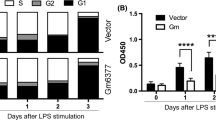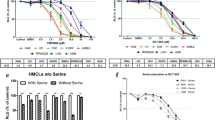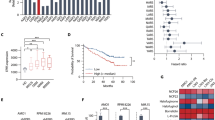Abstract
Amylase-producing myeloma exhibits refractoriness to chemotherapy and a dismal prognosis. In this study, we established a human myeloma cell line, 8226/AMY1, in which a lentivirally transfected AMY1 gene was stably expressed and explored its biological characteristics. 8226/AMY1 showed a survival advantage over mock control when treated with dexamethasone, bortezomib, and lenalidomide in vitro partly through inhibition of apoptosis induced by these reagents. In a xenograft murine model, 8226/AMY1 showed rapid tumor growth and reduced sensitivity to bortezomib compared with mock. A microarray gene expression analysis identified TCL1A, which functions as a coactivator of the cell survival kinase Akt, differentially up-regulated in 8226/AMY1. The expression of phosphorylated Akt was increased in the 8226/AMY1 cells following bortezomib treatment, but not in the mock cells. In addition, treatment with perifosine, an inhibitor of Akt phosphorylation, enhanced the anti-myeloma effect of bortezomib in the 8226/AMY1 cells. Our data suggest that amylase-producing myeloma reduced the sensitivity to bortezomib in vitro and in vivo, and the up-regulation of TCL1A may influence the drug susceptibility of 8226/AMY1 via the phosphorylation of Akt. These findings provide clues for developing treatment approaches for not only amylase-producing myeloma, but also relapsed and refractory myelomas.




Similar content being viewed by others
References
Ludwig H, Sonneveld P, Davies F, Bladé J, Boccadoro M, Cavo M, et al. European perspective on multiple myeloma treatment strategies in 2014. Oncologist. 2014;19:829–44.
Watanabe R, Tokuhira M, Kizaki M. Current approaches for the treatment of multiple myeloma. Int J Hematol. 2013;97:333–44.
Hata H, Matsuzaki H, Tanaka K, Nomura H, Kagimoto T, Takeya M, et al. Ectopic production of salivary-type amylase by a IgA-lambda-type multiple myeloma. Cancer. 1988;62:1511–5.
Matsuzaki H, Takatsuki K. Amylase producing multiple myeloma. Blood. 1989;74:889.
Tagawa S, Doi S, Taniwaki M, Abe T, Kanayama Y, Nojima J, et al. Amylase-producing plasmacytoma cell lines, AD3 and FR4, with der(14)t(8;14) and dic(8)t(1;8) established from ascites. Leukemia. 1990;4:600–5.
Fujii H, Yashige H, Kanoh T, Urata Y. Amylase-producing multiple myeloma. Arch Pathol Lab Med. 1991;115:952–6.
Pinelli M, Bindi M, Rosada J, Scatena P, Castiglioni M. Amylase: a disease activity index in multiple myeloma? Leuk Lymphoma. 2006;47:151–4.
Harborne SL, Curley R, Bullimore DW, Chan-Lam D, Ng JP, McAndrew PT. A case report of a salivary amylase secreting plasmacytoma in a patient with multiple myeloma. BMJ Case Rep. 2009;. doi:10.1136/bcr.08.2008.0639.
Sosnoff DR, Friend RB, Berkovic M, Rasansky RJ, Hoffman SM. Salivary amylase-producing multiple myeloma: case report and review of the current literature. J Clin Oncol. 2013;31:e309–11.
Ok SJ, Kim IS, Lee EY, Kang JE, Lee SM, Song MK. A case of salivary-type amylase-producing multiple myeloma presenting as mediastinal plasmacytoma and myelomatous pleural effusion. Ann Lab Med. 2014;34:463–5.
Sakai M, Ishikawa S, Yamamoto T, Onizuka M, Sakakibara Y, Noguchi M. A direct measurement of serum amylase levels produced by lung cancer. Ann Thorac Surg. 2005;79:1409–11.
Moriyama T. Sialyl salivary-type amylase associated with ovarian cancer. Clin Chim Acta. 2008;391:106–11.
Higashiyama M, Doi S, Tomita N, Monden T, Murotani M, Kawasaki Y, et al. Immunohistochemical analysis of amylase isoenzymes in thyroid cancer. J Clin Pathol. 1991;44:144–6.
Ri M, Iida S, Nakashima T, Miyazaki H, Mori F, Ito A, et al. Bortezomib-resistant myeloma cell lines: a role for mutated PSMB5 in preventing the accumulation of unfolded proteins and fatal ER stress. Leukemia. 2010;24:1506–12.
Gotou M, Hanamura I, Nagoshi H, Wakabayashi M, Sakamoto N, Tsunekawa N, et al. Establishment of a novel human myeloid leukemia cell line, AMU-AML1, carrying t(12;22)(p13;q11) without chimeric MN1-TEL and with high expression of MN1. Genes Chromosomes Cancer. 2012;51:42–53.
Morishita Y, Iinuma Y, Nakashima N, Majima K, Mizuguchi K, Kawamura Y. Total and pancreatic amylase measured with 2-chloro-4-nitrophenyl-4-O-beta-d-galactopyranosylmaltoside. Clin Chem. 2000;46:928–33.
Huber W, von Heydebreck A, Sültmann H, Poustka A, Vingron M. Variance stabilization applied to microarray data calibration and to the quantification of differential expression. Bioinformatics. 2002;18(Suppl 1):S96–104.
Tsunekawa-Imai N, Miwa H, Shikami M, Suganuma K, Goto M, Mizuno S, et al. Growth of xenotransplanted leukemia cells is influenced by diet nutrients and is attenuated with 2-deoxyglucose. Leuk Res. 2013;37:1132–6.
Weng J, Rawal S, Chu F, Park HJ, Sharma R, Delgado DA, et al. TCL1: a shared tumor-associated antigen for immunotherapy against B-cell lymphomas. Blood. 2012;120:1613–23.
Aggarwal M, Villuendas R, Gomez G, Rodriguez-Pinilla SM, Sanchez-Beato M, Alvarez D, et al. TCL1A expression delineates biological and clinical variability in B-cell lymphoma. Mod Pathol. 2009;22:206–15.
Hsu J, Shi Y, Krajewski S, Renner S, Fisher M, Reed JC, et al. The AKT kinase is activated in multiple myeloma tumor cells. Blood. 2001;98:2853–5.
Mitsiades N, Mitsiades CS, Poulaki V, Chauhan D, Fanourakis G, Gu X, et al. Molecular sequelae of proteasome inhibition in human multiple myeloma cells. Proc Natl Acad Sci USA. 2002;99:14374–9.
Chinen Y, Kuroda J, Shimura Y, Nagoshi H, Kiyota M, Yamamoto-Sugitani M, et al. Phosphoinositide protein kinase PDPK1 is a crucial cell signaling mediator in multiple myeloma. Cancer Res. 2014;74:7418–29.
Richardson PG, Wolf J, Jakubowiak A, Zonder J, Lonial S, Irwin D, et al. Perifosine plus bortezomib and dexamethasone in patients with relapsed/refractory multiple myeloma previously treated with bortezomib: results of a multicenter phase I/II trial. J Clin Oncol. 2011;29:4243–9.
Hata H, Matsuzaki H, Sanada I, Takatsuki K. Genetic analysis of amylase-producing cell lines: ectopic activation of the amylase gene by translocation. Jpn J Clin Oncol. 1990;20:246–51.
Acknowledgments
The authors would like to thank Ms. A. Nakamura for her valuable secretarial assistance and Brian Quinn for his editorial assistance. This study was supported by grants from the Ministry of Health, Labour and Welfare of Japan, the Ministry of Education, Culture, Sports and Technology of Japan, the SENSHIN Medical Research Foundation (Osaka, Japan), the Aichi Cancer Research Foundation (Nagoya, Japan), and the 24th General Assembly of the Japanese Association of Medical Sciences (Nagoya, Japan). The funders played no role in the study design, data collection and analysis, the decision to publish or the preparation of the manuscript.
Author information
Authors and Affiliations
Corresponding author
Ethics declarations
Conflict of interest
The authors declare no conflicts of interest.
Electronic supplementary material
Below is the link to the electronic supplementary material.
12185_2015_1859_MOESM1_ESM.pptx
Supplementary material 1 Supplementary Fig. 1. Representative histology (H&E) and immunohistochemistry (CD138) of 8226/AMY1 xenograft tumor (A), liver (B), bone marrow (C) and spleen (D) in xenotransplanted mice. There was no apparent infiltration of 8226/AMY1 cells into these organs in xenotransplanted mice. Supplementary Fig. 2. Array comparative genomic hybridization analysis of the innate amylase-producing human myeloma cell lines (FR4 and KMS12PE). Data indicated no alterations of the AMY1 copy number in these cell lines. (PPTX 1753 kb)
About this article
Cite this article
Mizuno, S., Hanamura, I., Ota, A. et al. Overexpression of salivary-type amylase reduces the sensitivity to bortezomib in multiple myeloma cells. Int J Hematol 102, 569–578 (2015). https://doi.org/10.1007/s12185-015-1859-0
Received:
Revised:
Accepted:
Published:
Issue Date:
DOI: https://doi.org/10.1007/s12185-015-1859-0




